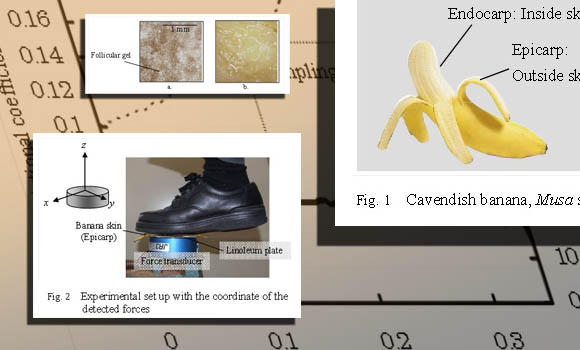
They feature so prominently in our Saturday morning cartoons and Charlie Chaplin movies that mankind has simply taken it as gospel that stepping on a banana peel will cause you to comically slip and fall with such a force that birds and stars will circle your head.
But did you know that until recently this was only a theory, unproven by a peer-reviewed scientific study? Thanks to the hard work done by Kiyoshi Mabuchi and his team at Kitasato University who were able to apply a frictional coefficient, we can unequivocally say that banana peels really are slippery when you step on them. Little wonder the group was awarded the 2014 Ig Nobel Prize in Physics.
At a ceremony held at Harvard University, Professor Mabuchi was present to accept his award, marking the eighth consecutive year that Japan was awarded an Ig Nobel Prize. When interviewed Professor Mabuchi said: “Banana peels being easy to slip on has been a self-evident thing, but I was able to scientifically prove it.”
The mechanics behind the banana peel’s legendary slipperiness are in tiny follicles on the inside skin. These little bubbles contain a gel-like substance that under normal circumstances isn’t terribly slippery. However, when pressure is applied, say from the foot of Wile E. Coyote, the membranes on these tiny follicles rupture and cause the gel to leak out and merge together creating a highly slick substance.
After examining the performance of this substance on various types of common flooring material, it was determined that a banana peel when stepped on with the inner side facing down will have a coefficient of friction (COF) of about 0.07, somewhere between a ski on snow and lubricated metal on metal. Although this information is useful in validating decades of comedic bits, Prof. Mabuchi is interested in the substance’s value as a potential lubricant for artificial limb joints.
So we salute the achievements of the team at Kitasato University and hope that some other research body in Japan can determine once and for all whether not realizing that you have just walked off the edge of a cliff will allow you to stay in the air.
Source: Improbable Research (English), Jijicom via Hachima Kiko (Japanese)
Professor Mabuchi and team’s report
Other Ig Nobel Prize winners for 2014
Neuroscience Prize
China/Canada
Jiangang Liu, Jun Li, Lu Feng, Ling Li, Jie Tian, and Kang Lee
For studying what happens in people’s brains when they see Jesus in a piece of toast
Psychology Prize
Australia/UK/USA
Peter K. Jonason, Amy Jones, and Minna Lyons
For building a case that people who stay up late are on average worse people than those who regularly wake up early in the morning
Public Health Prize
Czech Rep./Japan/USA/India
Jaroslav Flegr, Jan Havlíček, Jitka Hanušova-Lindova, David Hanauer, Naren Ramakrishnan and Lisa Seyfried
For looking into the potential dangers owning a cat might have on one’s mental health
Biology Prize
Czech Rep./Germany/Zambia
Vlastimil Hart, Petra Nováková, Erich Pascal Malkemper, Sabine Begall, Vladimír Hanzal, Miloš Ježek, Tomáš Kušta, Veronika Němcová, Jana Adámková, Kateřina Benediktová, Jaroslav Červený and Hynek Burda
For observing dogs’ preference to be aligned with Earth’s geomagnetic field when pooping or peeing
Art Prize
Italy
Marina de Tommaso, Michele Sardaro, and Paolo Livrea
For measuring the difference in pain sensitivity one has when being hit by a powerful laser and when looking at either a pretty or ugly painting
Economics Prize
Italy
National Institute of Statistics
For increasing the size of the national economy by including illegal business transactions between willing parties like prostitution or smuggling
Medicine Prize
USA/India
Ian Humphreys, Sonal Saraiya, Walter Belenky and James Dworkin
For treating nosebleeds by stuffing some cured pork up there
Arctic Science Award
Norway/Germany
Eigil Reimers and Sindre Eftestøl
For investigating how reindeer react to people dressed as polar bears
Nutrition Prize
Spain
Raquel Rubio, Anna Jofré, Belén Martín, Teresa Aymerich, and Margarita Garriga
For studying a method to ferment sausages using lactic acid bacteria from infant poop
Congratulations to all the winners!